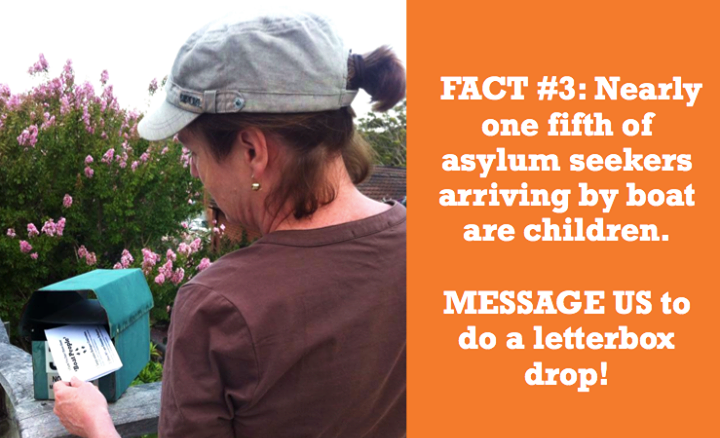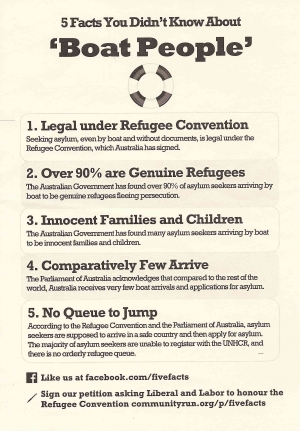
This article part of Right Now’s February Issue, focusing on Technology and Human Rights.
By Sarah George.
The rumours they were fed turned their prejudice into hatred. How could we sit and watch the nation call illegal what was legal, deceitful what was genuine, criminal what was innocent, many what was few, and the back door what was the only door? How could we let what was never true justify the mental torture that is indefinite detention with the possibility of deportation to certain death? These were the circumstances in which 5 Facts You Didn’t Know About “Boat People” was launched.
5 Facts You Didn’t Know About “Boat People” is a social media campaign with the goal of making the facts on asylum seekers mainstream knowledge. Like many social media campaigns, we aim to provide popular, shareable content that delivers information in fast and engaging ways. But good social media campaigning doesn’t end with shares – the goal should always be to move activists up the commitment ladder, resulting in offline actions and ultimately, solving real life problems. Great social media campaigning, such as that used in the Arab Spring, can result in a dramatic shift in a nation’s culture – and this is where we hope to end up.
Online protesting
Following the asylum seeker policy change in July 2013, protest rallies were held in every city almost every Saturday for several weeks, with tens of thousands of people attending in total. Sadly, these events barely registered on traditional media’s radars, and certainly didn’t reach the politicians with the power to change the policies. Eventually, the rallies stopped.

And so we took to social media. Nearly every Saturday since October last year, Five Facts activists have coordinated to post the same fact to the same politician on Facebook and Twitter. After several activists posted, “Australia only receives 3% of the world’s asylum seeker applications” to Scott Morrison’s Facebook page, this notice appeared, “Comments relating to the Immigration and Border Protection portfolio should be directed to minister@immi.gov.au and may be removed from this page.”
But unlike the death sentence that censorship had given the rallies, online censorship only added fuel to the fire. As each round of comments were deleted, more activists posted and took screenshots. Within hours, there were enough screenshots of deleted comments to create a Facebook album. Of course, this brought even more attention to the issue – one person wrote on the Minister’s page, “The power of social media sent me here for a look.”
Aside from venting our frustrations and potentially antagonising a prominent politician, why should activists engage in online action? Because it brings visibility to issues which are censored by our politicians and by traditional media. Social media is our own media – if it happens, an audience sees it.
Planning a popular campaign
There are many variables that affect how both activists and targets will respond to a campaign. Activists tend to get excited about campaigns that are timely, popular, high visibility, and where their action is low effort yet high impact. Social media campaigns that seemingly appear overnight and have everyone talking about them, with a quick result, are a campaigner’s dream.
Conveniently, if a campaign is popular with activists, targets are also more likely to respond to their requests, and for the same reasons. If the campaign addresses something they are currently doing or proposing to do, and is high visibility, their wider reputation’s under threat. If the campaign is popular, and there are many people taking low effort yet high impact actions, their consumer or supporter base is under threat.
As a result of social media campaigns which saw activists post comments on companies’ Facebook pages, Typo withdrew its pornography-themed school stationary line, Cotton On withdrew its risqué children’s line, and Coles remained strong in its much-opposed decision to support Animals Australia.
Identifying the critical path
Social media campaigns have unlimited potential. They can achieve high visibility in a very short period of time, and with a well-thought out plan in place, they can mobilise unlimited numbers of people to do almost anything. The challenge for campaigners is to develop a critical path – to ensure there’s a clear connection between what they’re doing online and what they want to achieve in real life.
To work out a critical path, we have to imagine the problem being solved, and what that looks like. Then we have to work backwards – what happened just before the problem was solved, what steps did we take to get there, and how did we use social media? The answers to these questions become our critical path – our blueprint for how our social media campaign will solve the real life problem.
The truth is, social media campaigns really can solve real life problems. But it takes courage to carry them out with every intention of succeeding. On social media, we’re no longer censored; everyone has equal opportunity to have his or her voice heard. It’s time to forget we’re the same group of people who stood in the rain, placards disintegrating, silenced before we even started chanting. It’s time to remember to speak like the whole world is listening – because now they are.
Sarah George is a Perth-based human rights campaigner. Her work has focused particularly on asylum seekers, homelessness and modern slavery.

